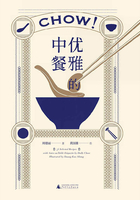
PREFACE FOR THE REPRINTED VERSION
Great-grand-aunt Dolly Chow was known for being a largerthan-life fun-loving lady. She was raised in Shanghai where her father Sir Chow Shouson(周寿臣爵士), a member of the first Chinese Educational Mission to the West and a prominent trade official during the Qing dynasty, served the nation in a number of government posts. In addition to being attentive to a busy husband [C.T. Wang(王正廷), an international diplomat, community leader and father of our Chinese Olympics] and overseeing a household, great-grand-aunt Dolly herself had great culinary skills and was a gracious hostess. An invitation to dinner at the Wang household was highly appreciated.
Great-grand-aunt Dolly decided to commit her culinary knowledge to paper, and so she infused her family's private banquet menu with traditional Chinese table etiquette and drafted it all into a book entitled “Chinese Recipes”(《中国食谱》)  . Greatgrand-aunt Dolly and great-grand-uncle C.T. had many western friends and Dolly wanted to share our Chinese culture with them by introducing them to the philosophy of traditional Chinese dining and etiquette. This was her main purpose for writing this book. She observed that the common preference among her international guests was to taste various types of Chinese cooking. Therefore, great-grand-aunt Dolly's book was written in both Chinese and English for everyone to enjoy. First published in 1936 in Shanghai then reprinted 68 times in Shanghai, Hong Kong, Tokyo and New York, the book has sold over 300,000 copies.
. Greatgrand-aunt Dolly and great-grand-uncle C.T. had many western friends and Dolly wanted to share our Chinese culture with them by introducing them to the philosophy of traditional Chinese dining and etiquette. This was her main purpose for writing this book. She observed that the common preference among her international guests was to taste various types of Chinese cooking. Therefore, great-grand-aunt Dolly's book was written in both Chinese and English for everyone to enjoy. First published in 1936 in Shanghai then reprinted 68 times in Shanghai, Hong Kong, Tokyo and New York, the book has sold over 300,000 copies.
Today Chinese customs and practices are not such a mystery to the West as they were in great-grand-aunt Dolly's day. However we feel a sense of mission driving us to republish the book. As Chinese society has undergone extreme changes, in terms of economic growth and social transformation over the last 70 years, many young people have forgotten or have never learned that like westerners, we Chinese have a tradition of table etiquette and manners. Young people tend to think that table etiquette and manners are derived and imported from western civilization. Far from it.
Our young Chinese generation would gain by remembering the teachings of humility and grace passed down from the social teachings of Confucius, teachings that deal with the proper behavior and manners of the individual in society. Confucius had many rules on dining etiquette as he believed the function of eating was not only a way to satisfy one's appetite but was also the most important means of social interaction. Chinese table etiquette and manners may seem unremarkable, but they are indeed profound.
I have often shared this book with my young Chinese friends in both China and abroad. It is my way of inspiring others to read and learn more about our Chinese heritage, to be more knowledgeable about our social history, to understand the deep roots that table etiquette and manners have in Chinese culture and to be proud of our culture. Just as importantly, I believe this book will give young people important advantages as they progress through society and interact with people from a wide variety of cultures. To that end, I have added commentary to select chapters that helps bridge the gap between the 1930s and today.
In all cultures, a shared meal is at the centre of life's most important moments. Whether dining for business or pleasure, whether meeting one's spouse for the first time or one's future boss, proper manners and etiquette will carry one a long way.
This book has been out of print for a long time and can hardly be found today. Thanks to the support of Guangxi Normal University Press, this book is being republished. Thanks to Mr. Xu Zhongliang for providing his support. Mr. Xu also engaged Ms. Liu Yanqi who formerly was a United Nations translator to translate parts of the book from English to Chinese.The layout and illustrations have been kept intact from the original edition and enhance the book's traditional charm.
Carolyn Hsu徐芝韵
New York, June 2018